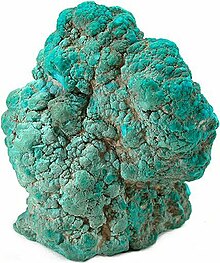Tourquoise
| Turquoise | |
|---|---|
 |
|
| General | |
| Category | Phosphate minerals |
|
Formula (repeating unit) |
CuAl6(PO4)4(OH)8·4H2O |
| Strunz classification | 8.DD.15 |
| Crystal system | Triclinic |
| Crystal class | Pinacoidal (1) (same H–M symbol) |
| Identification | |
| Colour | Turquoise, blue, blue-green, green |
| Crystal habit | Massive, nodular |
| Cleavage | Good to perfect_usually N/A |
| Fracture | Conchoidal |
| Mohs scale hardness | 5–6 |
| Lustre | Waxy to subvitreous |
| Streak | Bluish white |
| Specific gravity | 2.6–2.9 |
| Optical properties | Biaxial (+) |
| Refractive index |
nα = 1.610 nβ = 1.615 nγ = 1.650 |
| Birefringence | +0.040 |
| Pleochroism | Weak |
| Fusibility | Fusible in heated HCl |
| Solubility | Soluble in HCl |
| References | |
Turquoise is an opaque, blue-to-green mineral that is a hydrated phosphate of copper and aluminium, with the chemical formula CuAl6(PO4)4(OH)8·4H2O. It is rare and valuable in finer grades and has been prized as a gemstone and ornamental stone for thousands of years owing to its unique hue. In recent times, turquoise has been devalued, like most other opaque gems, by the introduction onto the market of treatments, imitations, and synthetics.
Known by many names, the word turquoise dates to the 17th century and is derived from the French turquois for "Turkish" because the mineral was first brought to Europe from Turkey, from mines in the historical Khorasan Province of Persia.Pliny the Elder referred to the mineral as callais and the Aztecs knew it as chalchihuitl.
The finest of turquoise reaches a maximum Mohs hardness of just under 6, or slightly more than window glass. Characteristically a mineral, turquoise almost never forms single crystals, and all of its properties are highly variable. X-ray diffraction testing shows its crystal system to be triclinic. With lower hardness comes lower specific gravity (2.60–2.90) and greater porosity: These properties are dependent on grain size. The lustre of turquoise is typically waxy to subvitreous, and transparency is usually opaque, but may be semitranslucent in thin sections. Colour is as variable as the mineral's other properties, ranging from white to a powder blue to a sky blue, and from a blue-green to a yellowish green. The blue is attributed to idiochromatic copper while the green may be the result of either iron impurities (replacing aluminium) or dehydration.
...
Wikipedia
